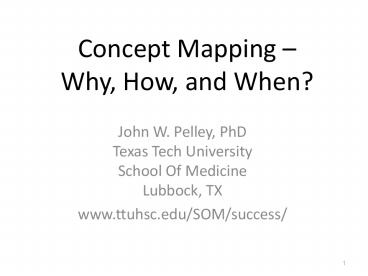Concept Mapping – Why, How, and When? PowerPoint PPT Presentation
1 / 28
Title: Concept Mapping – Why, How, and When?
1
Concept Mapping Why, How, and When?
- John W. Pelley, PhDTexas Tech University School
Of MedicineLubbock, TX - www.ttuhsc.edu/SOM/success/
2
Concept Mapping Why
- Visual organization of relationships
- Visual structure aids long term memory
- Active learning requires decisions based on
- Inspection list
- Identification group
- Understanding compare
3
Concept Mapping Why
- Sensing types can learn intuitive type skills
- Discovery of patterns relationships
- Improved ruling-out thinking
- Intuitive types can learn sensing type skills
- Recall of facts not in big picture
- Improved time on task
- Helps change the brain for Ss and Ns
4
Concept Mapping Examples
- Key terms enclosed in bubbles
- Connections are propositions describe
relationship - Branches represent groupings and organization
- Cross-links represent comparisons
- So, how are facts represented?
5
(No Transcript)
6
(No Transcript)
7
(No Transcript)
8
Sequence Illustrating Rotator Cuff Concept Map
(Upper Extremity)
- These maps could be grouped on a poster pad or
kept separate. - Maps are correct whether top-down or
center-out
9
(No Transcript)
10
(No Transcript)
11
(No Transcript)
12
(No Transcript)
13
(No Transcript)
14
(No Transcript)
15
(No Transcript)
16
(No Transcript)
17
More About Maps
- Remember that maps are living documents they
grow as you learn - Maps dont have to include everything
- Maps are the best study notes
- Maps allow you to compare your thinking
- and improve it!
18
How to Concept Map
- List or highlight the major concepts from notes
or text. - Try a regular outline if more comfortable
- Identify the most general concepts (grouping).
- Arrange with most general concepts at the top
- Label connecting lines to explain the
relationship, if needed. - Arrowheads can show direction, cause-and-effect,
etc.
19
How to Concept Map
- Try to branch out at each level of the hierarchy
with more than one link. - Reading becomes more normal now
- Identify and draw cross-links between related
concepts. - This is a powerful step in developing integrative
thinking. - Alternative patterns A spider or cluster
pattern can be constructed from the center
outward, but this will not be seen as readily by
linear learners.
20
Overview of Mapping
- List Group Compare
- 1. List important terms
- 2. Group by major topic
- 3. Compare by drawing cross-links
21
Concept Map Exercise
- Use anything you want to learn.
- Chapter
- Section within a chapter
- Review article
- Lecture notes
- Develop a list of grouping terms.
- Organize into a one-level map?
- Can you see a 2-level map?
- How did it affect your thinking?
- Frustrating? Enlightening? Slow? Fast?
22
Lecture 1 a. introduction med school first year
overview. med school study tips. histology
overview and study tips. pre-mat histology
overview and goals. b. staining methods HE,
PAS, silver, and Verhoeff's (show
histology examples of each). c. the cell plasma
membrane, nucleus and nucleolus, lysosomes,
mitochondria, cytoskeleton. Discuss function,
structure (show histology images), and
disorders. d. mitosis vs. meiosis and common
disorders (trisomy 13, 18, and 21).
23
Lecture 2 Epithelium a. define terms (ie,
simple, stratified, squamous, cuboidal, columnar,
etc). b. show histology examples of each type of
epithelium and list one or two common places in
body each is found. c. define exocrine vs.
endocrine glands. Define holocrine, merocrine,
and apocrine secretion. Show image examples of
sweat and sebaceous glands. d. define a few
epithelial cell disorders (Kartagener's syndrome,
cystic fibrosis, and Barret's esophagous with
gastroesophageal reflux).
24
Lecture 3 Connective Tissue a. types and
examples of each (loose, dense, and specialized
like cartilage, bone, adipose, and blood). b.
composition (ground substance, water, cells, and
fibers like collage 1,2,3,4 and elastin). c.
cartilage and bone show example image, examples,
major characteristics, and disorders related to
cartilage and bone. d. adipose show example
image, discuss structure, white vs. brown fat. e.
blood show example image, types (RBC, WBC,
platelets), hematopoiesis (image examples of each
stage), granulopoiesis (image examples of each
stage), blood serum vs. plasma, blood disorders
(sickle cell and pernicious anemia, acute
promyelocytic leukemia with histology image
examples).
25
Lecture 4 Nervous System Tissue a. organization
(CNS vs. PNS). b. microanatomy of the neuron
(dendrites, cell body, axon, nissl substance and
axon hillock, myelin, synaptic cleft). Define
nerve vs. neuron, endoneurium, perineurium, and
epineurium as well. c. types of neurons and image
examples of each. d. action potentional and
neurotransmitter release. e. other cells of
nervous system astrocytes, oligodendrocytes,
satellite cells, and schwann cells. Oligo vs.
schwann cell myelination differences. f. nerve
injury and degeneration (Wallerian and segmental
degeneration). g. nervous system disorders
multiple sclerosis, depression, schizophrenia.
Discuss how lidocaine works.
26
Recommended computer programCmap Tools
- Only if you must
- Most people prefer hand drawn
- Cmap Tools at cmap.ihmc.us
- Free program
- Very easy to use
27
(No Transcript)
28
Concept Mapping When
- 2- Level map before lecture
- Complete as soon as possible after a
lecture/conference/reading assignment - When the material will be on a test
- When you will have to report on something
- When you want to re-organize something
- When you have a question for the professor

